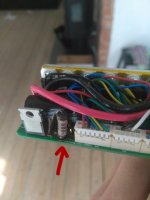Ifihadahifi
1 µW
- Joined
- Mar 19, 2018
- Messages
- 3
Hi all of you enthusiastic people! I am trying to repair an e-bike (hub motor, some Chinese no brand controller) and I got a new controller. The bike came to life but died again shortly thereafter. I opened up both the old and the new, identical controller and found a component that looks burnt (see picture) and seems busted after checking with multimeter. The marking on the circuit board says "Rt1". Any ideas on what this is? Resistor, Thermistor, fuse or something else? Would like to repair instead of buying a new controller if possible.
Thanks a lot for any help you can provide. I'm a noob in this area
Edit: Measured the component in a very similar controller (same bike model but newer). 50 ohms resistance in a functioning one. Seems to get really hot even in this one, melting away at some nearby cables
Thanks a lot for any help you can provide. I'm a noob in this area
Edit: Measured the component in a very similar controller (same bike model but newer). 50 ohms resistance in a functioning one. Seems to get really hot even in this one, melting away at some nearby cables


